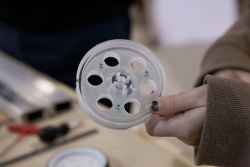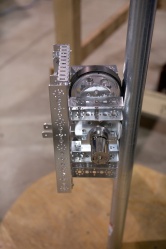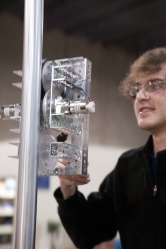Difference between revisions of "DEWBOT VII Minibot"
MaiKangWei (talk | contribs) (→Goliath) |
MaiKangWei (talk | contribs) (→Goliath) |
||
| Line 35: | Line 35: | ||
image:DB7_pc_wheel_110123_csm.jpg|Custom turned polycarbonate wheel for Goliath (and leter ''Beam-bot'' | image:DB7_pc_wheel_110123_csm.jpg|Custom turned polycarbonate wheel for Goliath (and leter ''Beam-bot'' | ||
image:DB7_Minibot_test_110123_csm.jpg|Goliath's first time on the pole. | image:DB7_Minibot_test_110123_csm.jpg|Goliath's first time on the pole. | ||
| − | image: | + | image:DB7_minibot_Douglas_110125_csm.jpg|Goliath climbs the pole past Douglas |
</gallery> | </gallery> | ||
Revision as of 23:46, 14 March 2011
Having a deployable Minibot was a key strategic objective from our Strategy Session. In addition:
- Minibot must remain on Post during race - MUST
- Minibot to climb post in xx sec - MUST, but xx was poorly defined during the strategy session
- Minibot must exert enough force to close switch - MUST
- Minibot should power-down and come down Post after reaching top - MUST
Contents
Early Analysis of the Minibot Problem
Email from Clem (1/24): I've adapted my 2008 robot drive-train model to the problem of FRC's 2011 MiniBot race. Model and some sample results are attached. I am not sure that all physical parameters (normal force on wheels to the pole, coefficients of friction,...) are correct. The model and results are provided as samples of what a model can provide.
I used a 0.5:1 gear reduction for the sample cases. I assumed 10 lb normal force holding the minibot to the pole and high-friction wheel surfaces (probably not so realistic).
I ran the cases for 4.5, 5.0 & 5.5 lb robots. Wheel radius was varied between 1.5 and 2.3 in in 0.1 in steps.
The primary factor affecting climb time is minibot mass. No big surprise here. The lighter, the faster.
However, wheel radius (a.k.a. gear ratio) plays a significant role and there is an optimum which is a function of robot mass. Given that we have fixed geal ratios (based on the Tetrix gears), the ability to turn a custom-radius wheel could provide a useful competitive advantage. Optimizing wheel diameter/gear ratio can cut tenths of a second off the climb time.
So, to win the Minibot race:
1. Minimize Minibot mass (seconds to be saved here)
2. Deploy quickly
3. Optimize wheel diameter/gear ratio (tenths of seconds to be saved)
Regards, Clem
The effects or minibot mass and drive wheel radius was explored in detail - 31 Jan 2011, Clem
Stages of Minibot Evolution
Minibot design went through a discontinuous evolution during and after build season.
Goliath
- Our first Minibot, in large measure the child of mentor Juan Posada, was not formally named during its lifetime. In retrospect, the name Goliath seems appropriate.
- Goliath had front & back custom concave polycarbonate wheels (tres cool), with a bank of rare-earth magnets between them. It fell off the pole when both wheels were powered, leading to the white paper:
- Will my magnetic minibot fall off the pole when the power starts up? What do I do? Find out here & do the math! - 24 Jan 2011, Clem
- Will my magnetic minibot fall off the pole when the power starts up? What do I do? Find out here & do the math! - 24 Jan 2011, Clem
- Driving the front wheel only avoided the falling off the pole problem, but introduced wheel slippage.
- Goliath also inspired the adaptation of the robot Drive-train model to a Minibot-specific Model.
- Mass was ??. A little avoirdupois, Goliath did not sprint yo to pole's top.


